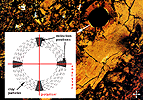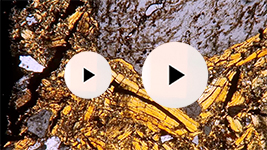Illuvial clay accumulations are characterised by specific features, both as regards their optical properties and the way they are distributed through the soil.
![]() Optical properties
Optical properties
The clay particles, due to their size, remain outside the
resolutionary power of the optic microscope. This is why they are not studied
individually in micromorphology but are described in groups.
PPL (only polariser). Although on their own they are colourless, clay masses generally are yellowish in colour when the Fe+++ is present in a hydrated form. They are reddish if the Fe+++ content is high in anhydrous form, and only in hydromorphous soils (without any Fe+++ content or saturated with Fe++) they are greyish.
 XPL
(polariser + analyser) With the polarizer and analyser
crossed, the clay masses should not show any anisotropy and therefore remain
in extinction (black or dark grey), as although they are anisotropic crystals,
due to their small size, the birefringence produced is minimal. On the other
hand, as the thickness of a microscopic preparation is about 30 µm, the
light will pass through many particles and as these are oriented at random,
the different effects introduced by each tiny crystal will be compensate one
another, finally annulling the optical effects.
XPL
(polariser + analyser) With the polarizer and analyser
crossed, the clay masses should not show any anisotropy and therefore remain
in extinction (black or dark grey), as although they are anisotropic crystals,
due to their small size, the birefringence produced is minimal. On the other
hand, as the thickness of a microscopic preparation is about 30 µm, the
light will pass through many particles and as these are oriented at random,
the different effects introduced by each tiny crystal will be compensate one
another, finally annulling the optical effects.
 Due to their laminar habit, however, the
clay particles tend to be oriented parallel to one another. The result is that
in a domain of oriented clay, the optical phenomena of each individual particle
is added to those next to it, the domain acting as if it were a single crystal,
showing distinctive optical properties: interference colour, extinction phenomena,
etc.
Due to their laminar habit, however, the
clay particles tend to be oriented parallel to one another. The result is that
in a domain of oriented clay, the optical phenomena of each individual particle
is added to those next to it, the domain acting as if it were a single crystal,
showing distinctive optical properties: interference colour, extinction phenomena,
etc.
Additionally, the definition of the extinction represents the degree of orientation of the clay particles.
Kandites show low (grayish) interference colours, vermiculites and smectites higher colours of first or second order. Due to the presence of iron, abnormal yellow or red interference colours may appear.
![]() Location
Location
As illuvial clay accumulations occur due to the immobilisation of suspensions, they are localised, associated with larges pores, although in the dynamic horizons they could become part of the soil mass.
In general, they are found in the form of fairly films (think, median, thick) coating the walls of the macropores (PPL, XPL) and covering the aggregates and mineral grains or completely filling the voids.
